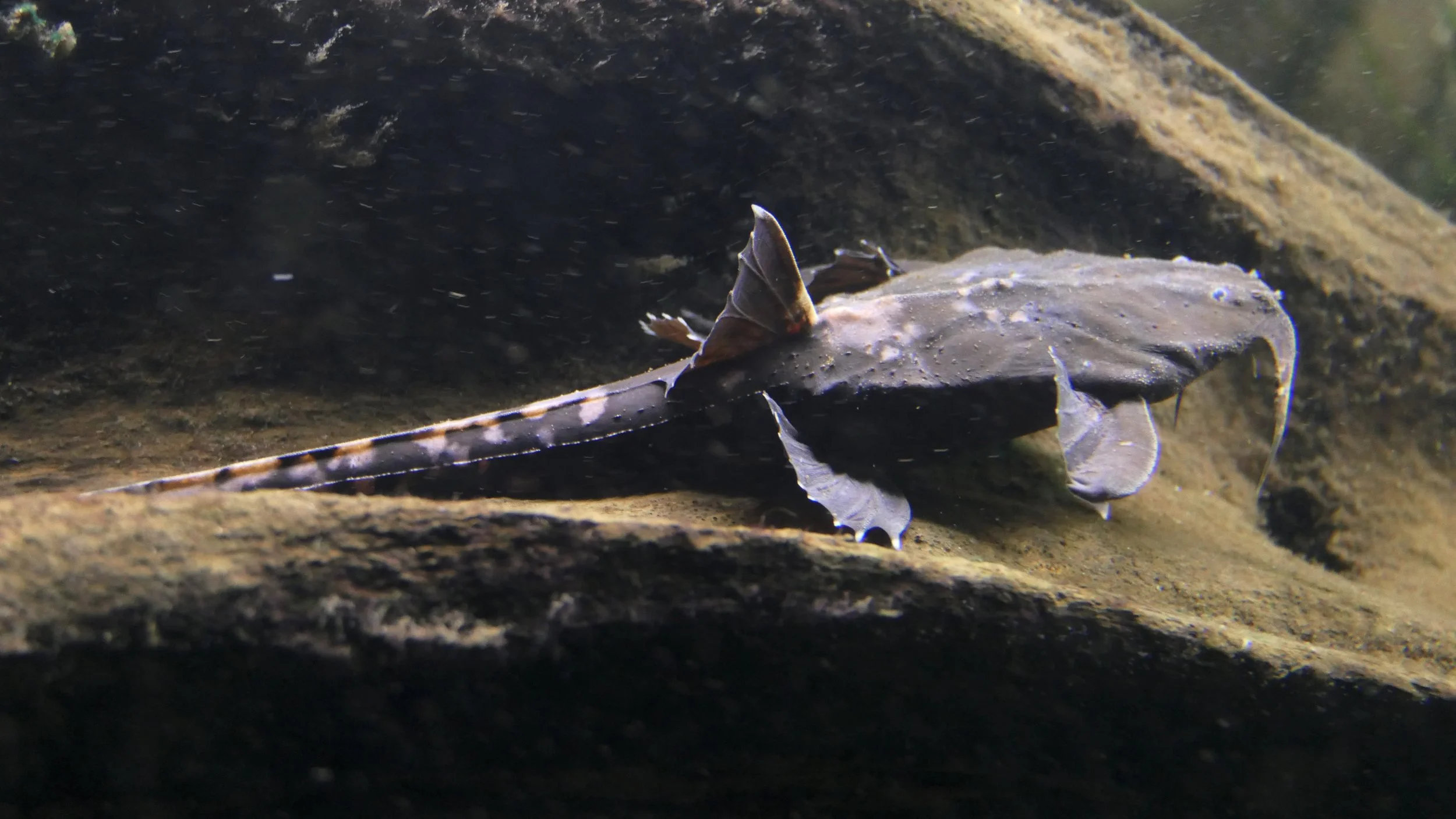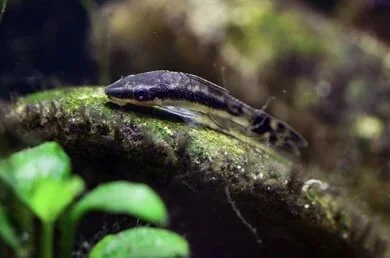Red Lizard Whiptail
Whiptail catfish are a diverse group of catfish species known for their unique appearance, characterized by their long, slender bodies and a whip-like extension of their tails. They are commonly kept in aquariums, and their care requirements can vary slightly depending on the specific species. Here's a general care guide for whiptail catfish:
Tank Setup:
Tank Size:
Provide a tank that is at least 20 gallons for a small group of whiptail catfish. Larger species may require larger tanks.
Substrate:
Use a fine substrate, such as sand or smooth gravel, to prevent injury to their delicate barbels.
Decorations:
Include hiding spots like caves, driftwood, and plants. Whiptails appreciate places where they can rest and feel secure.
Filtration:
Use a good-quality filtration system to maintain water quality. Whiptail catfish are sensitive to poor water conditions.
Water Parameters:
Keep the water temperature between 75°F to 82°F (24°C to 28°C).
Maintain a pH level between 6.5 and 7.5.
Aim for moderate water hardness, with a dH range of 5-15.
Diet:
Feeding:
Whiptail catfish are generally omnivores. Provide a well-balanced diet consisting of high-quality sinking pellets, flakes, and frozen or live foods.
Supplement their diet with algae wafers and fresh vegetables like blanched spinach or zucchini.
Feeding Frequency:
Feed them once or twice a day, offering an amount they can consume in a few minutes.
Tank Mates:
Compatibility:
Whiptail catfish are generally peaceful, but avoid keeping them with aggressive or overly territorial tank mates.
Schooling:
Keep them in groups of at least three individuals, as they are social and feel more secure in a school.
Behavior:
Nocturnal Behavior:
Whiptail catfish are often more active during the night. Provide low lighting during the day to mimic their natural habitat.
Territoriality:
Some species may exhibit territorial behavior, especially during breeding. Provide ample hiding spaces to reduce aggression.
Health:
Observation:
Regularly observe their behavior and appearance. Changes may indicate stress, illness, or other issues.
Quarantine:
Quarantine new fish before introducing them to the main tank to prevent the spread of diseases.
Water Changes:
Perform regular water changes to maintain optimal water quality.
Breeding:
Breeding Conditions:
Breeding whiptail catfish in captivity may require specific conditions, including slightly warmer water and appropriate hiding spots.
Separation:
If breeding occurs, consider separating the adults from the eggs or fry to prevent predation.
Always research the specific species you have to ensure you are meeting their unique requirements. Consulting with experienced aquarists or specialists can also provide valuable insights into the care of whiptail catfish.
Whiptail catfish are a diverse group of catfish species known for their unique appearance, characterized by their long, slender bodies and a whip-like extension of their tails. They are commonly kept in aquariums, and their care requirements can vary slightly depending on the specific species. Here's a general care guide for whiptail catfish:
Tank Setup:
Tank Size:
Provide a tank that is at least 20 gallons for a small group of whiptail catfish. Larger species may require larger tanks.
Substrate:
Use a fine substrate, such as sand or smooth gravel, to prevent injury to their delicate barbels.
Decorations:
Include hiding spots like caves, driftwood, and plants. Whiptails appreciate places where they can rest and feel secure.
Filtration:
Use a good-quality filtration system to maintain water quality. Whiptail catfish are sensitive to poor water conditions.
Water Parameters:
Keep the water temperature between 75°F to 82°F (24°C to 28°C).
Maintain a pH level between 6.5 and 7.5.
Aim for moderate water hardness, with a dH range of 5-15.
Diet:
Feeding:
Whiptail catfish are generally omnivores. Provide a well-balanced diet consisting of high-quality sinking pellets, flakes, and frozen or live foods.
Supplement their diet with algae wafers and fresh vegetables like blanched spinach or zucchini.
Feeding Frequency:
Feed them once or twice a day, offering an amount they can consume in a few minutes.
Tank Mates:
Compatibility:
Whiptail catfish are generally peaceful, but avoid keeping them with aggressive or overly territorial tank mates.
Schooling:
Keep them in groups of at least three individuals, as they are social and feel more secure in a school.
Behavior:
Nocturnal Behavior:
Whiptail catfish are often more active during the night. Provide low lighting during the day to mimic their natural habitat.
Territoriality:
Some species may exhibit territorial behavior, especially during breeding. Provide ample hiding spaces to reduce aggression.
Health:
Observation:
Regularly observe their behavior and appearance. Changes may indicate stress, illness, or other issues.
Quarantine:
Quarantine new fish before introducing them to the main tank to prevent the spread of diseases.
Water Changes:
Perform regular water changes to maintain optimal water quality.
Breeding:
Breeding Conditions:
Breeding whiptail catfish in captivity may require specific conditions, including slightly warmer water and appropriate hiding spots.
Separation:
If breeding occurs, consider separating the adults from the eggs or fry to prevent predation.
Always research the specific species you have to ensure you are meeting their unique requirements. Consulting with experienced aquarists or specialists can also provide valuable insights into the care of whiptail catfish.
Whiptail catfish are a diverse group of catfish species known for their unique appearance, characterized by their long, slender bodies and a whip-like extension of their tails. They are commonly kept in aquariums, and their care requirements can vary slightly depending on the specific species. Here's a general care guide for whiptail catfish:
Tank Setup:
Tank Size:
Provide a tank that is at least 20 gallons for a small group of whiptail catfish. Larger species may require larger tanks.
Substrate:
Use a fine substrate, such as sand or smooth gravel, to prevent injury to their delicate barbels.
Decorations:
Include hiding spots like caves, driftwood, and plants. Whiptails appreciate places where they can rest and feel secure.
Filtration:
Use a good-quality filtration system to maintain water quality. Whiptail catfish are sensitive to poor water conditions.
Water Parameters:
Keep the water temperature between 75°F to 82°F (24°C to 28°C).
Maintain a pH level between 6.5 and 7.5.
Aim for moderate water hardness, with a dH range of 5-15.
Diet:
Feeding:
Whiptail catfish are generally omnivores. Provide a well-balanced diet consisting of high-quality sinking pellets, flakes, and frozen or live foods.
Supplement their diet with algae wafers and fresh vegetables like blanched spinach or zucchini.
Feeding Frequency:
Feed them once or twice a day, offering an amount they can consume in a few minutes.
Tank Mates:
Compatibility:
Whiptail catfish are generally peaceful, but avoid keeping them with aggressive or overly territorial tank mates.
Schooling:
Keep them in groups of at least three individuals, as they are social and feel more secure in a school.
Behavior:
Nocturnal Behavior:
Whiptail catfish are often more active during the night. Provide low lighting during the day to mimic their natural habitat.
Territoriality:
Some species may exhibit territorial behavior, especially during breeding. Provide ample hiding spaces to reduce aggression.
Health:
Observation:
Regularly observe their behavior and appearance. Changes may indicate stress, illness, or other issues.
Quarantine:
Quarantine new fish before introducing them to the main tank to prevent the spread of diseases.
Water Changes:
Perform regular water changes to maintain optimal water quality.
Breeding:
Breeding Conditions:
Breeding whiptail catfish in captivity may require specific conditions, including slightly warmer water and appropriate hiding spots.
Separation:
If breeding occurs, consider separating the adults from the eggs or fry to prevent predation.
Always research the specific species you have to ensure you are meeting their unique requirements. Consulting with experienced aquarists or specialists can also provide valuable insights into the care of whiptail catfish.






